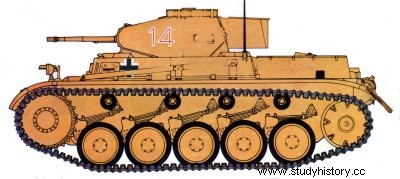
PzKpfw 11 or SdKfz 121 Ausf A to F
Country Germany
Type: light tank.
Crew: 3 men.
Arming: a 2 cm KwK 30 or 38 gun, a 7.92 mm MG34 coaxial.
Shielding: minimum 10 mm, maximum 30 mm in Ausf A, B and C; minimum 14.5 mm, maximum 35 mm in the Ausf F.
Weight: 9.5t.
Ground Pressure :0.8kg/cm2
Mass power :13.9 ch/t.
Engine :Maybach HL 62 TR 6 cyl. in-line water-cooled gasoline engine, developing 130 hp at 2,600 rpm.
Performance:
road speed , 40 km/h;
autonomy: 192km;
vertical obstacle, 0.43 m.
straight cut: 1.72m;
ford :0.91m;
slope, 50%.
Service Time :in the German army from 1936 to 1943. Also employed by Spain.
The PzKpfw was the second transitional vehicle introduced into the German army before the war, when it became clear that the production of more powerful tanks would suffer some delay.
The factories struggled on the manufacture of these last models and, when the persons in charge understood that it would be necessary to await at least 1938 to put in service the heavy tanks, they decided to build a second series of transition this time in the bracket of the 10t. /P>
The call for tenders was launched in 1935 and the final choice fell on the design from the MAN company. Several prototypes were made. some sent to Spain for full combat testing program.
The first production models appeared in 1935 but deliveries were delayed over the next eighteen months because the general design had to be modified.
The armor was reinforced, especially at the front some changes were made to the suspension. The weight increased by nearly 2 t and various methods were experimented with to improve engine performance. The overboring of the cylinders of the Maybach brought 10 additional hp but the old engine seems to have been maintained on certain versions.
The three variants of the PzKpfw II, the Ausfuhrungen A, B and C presented only minor differences; only their respective dimensions changed. The Ausf A had the original engine, with lower power, and weighed 7.3 t A hundred copies left the factory in 1935 and 1936 The Ausf B was equipped with the improved engine. new gearboxes. new caterpillars. all of which further increases the weight. The Ausf C, which appeared in 1937, carried thicker frontal armor, bringing the final weight to 9.5 t
Deliveries to units began systematically in 1937 and by 1939, industry had enabled more than 1,000 PzKpfw IIs to be fielded in the Polish campaign.
The manufacture of the general type continued until the end of 1942 or the beginning of 1943, a time when it appeared definitively surpassed by the adversary. From the campaign of France, in 1940, the insufficiency of the armament and shielding was obvious although the tank represented the ideal for the reconnaissance missions.
The hull was a heat treated wrought steel assembly. 30 mm thick at the front 10 mm on the side walls and at the back. The engine was placed in the rear compartment. the transmission system running along the combat chamber to reach the gearbox and the side reduction gears at the front
. The gearbox was a ZF with six forward gears and one reverse. the steering being ensured by clutch and braking. The driving position was moved to the left. just like the turret, which surmounted the combat chamber.
Although better than on the PzKpfw I, the armament was not yet a model of efficiency. The 2cm had a maximum range of 600m and fired only armour-piercing ammunition; its rate of fire, however, was reasonable.
The ammunition load was 180 rounds of 2 cm and 1,425 rounds
of 7.92 mm; nevertheless, these 2 cm shells did not really shine with their piercing power.
Again, the optical field in the turret was greatly reduced and the conduct of fire difficult when the vehicle was with all the hatches closed.
It seems that most IIs were equipped with the radio The suspension, on the other hand, was quite characteristic.
Five road wheels were suspended by quarter-ellipse leaf springs, the tension wheel at the rear (and the sprocket at the fun front and the other raised.
This undercarriage was efficient and within the limits imposed by its power unit. The PzKpfw II showed good maneuverability. The tracks were narrow but, it seems, of sufficient strength. Despite these constraints from its initial design , the PzKpfw II formed the backbone( of the Panzerdivisionen and, in April 1942.
860 of them were still on the staffing tables. when they were on the verge of senility
At the end of 1940, the F variant appeared, an attempt to improve performance. The front and side armor was reinforced and the machine now mounted a higher muzzle velocity gun although the caliber still did not exceed 2 cm.
However, these modifications only slightly improved the tactical value of the tank but increased the overall weight by one ton. additional load for the motor.
The basic chassis was used for the construction of several mission-specific machines and also as a test bed for various theories, including the use of a torsion bar suspension. Some became flamethrower vehicles capable of sending some 80 jets of fire, lasting 2 to 3 seconds, to a distance of 35 m. About 55 chassis were converted into amphibious vehicles for the invasion of Britain but the experience was disappointing.
Several anti-tank SFG versions are described under other headings.
The PzKpfw II eventually disappeared discreetly from the battlefield after teaching armored warfare to Wehrmacht soldiers during the difficult period preceding the outbreak of hostilities.
With a good crew, the tank could do more than defend itself, but its armament was always too light
